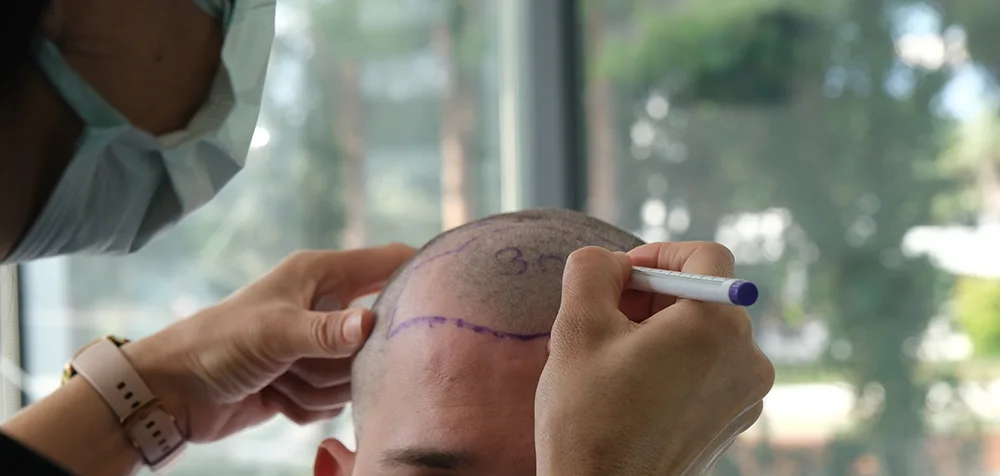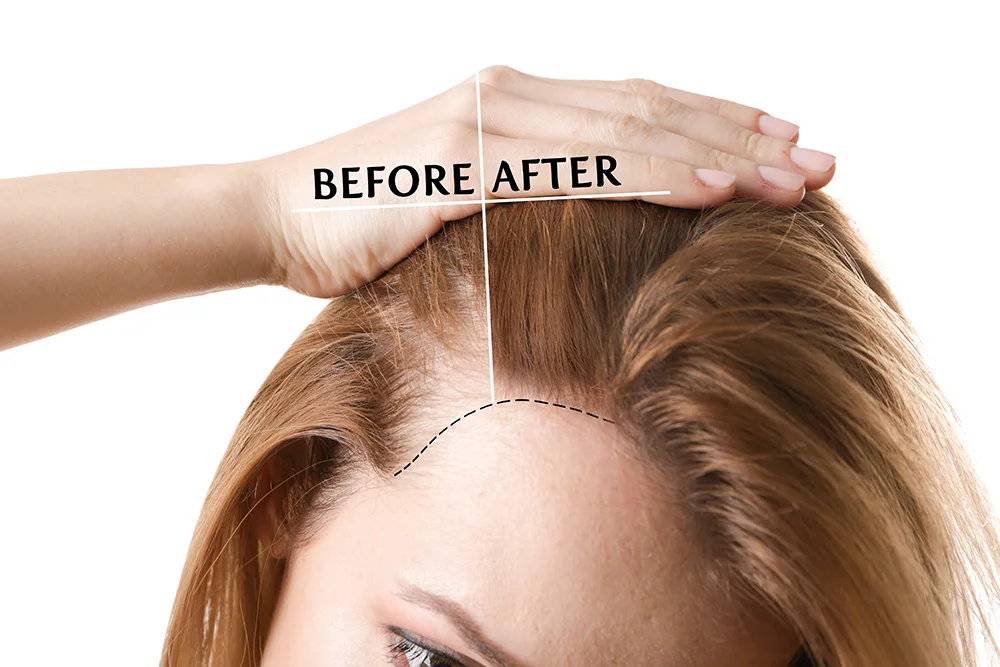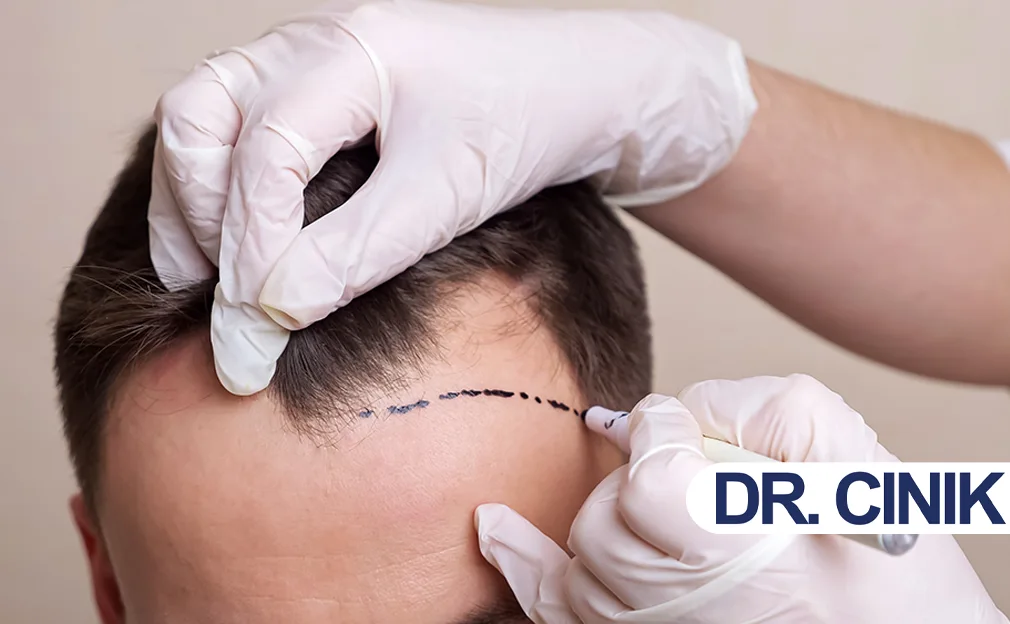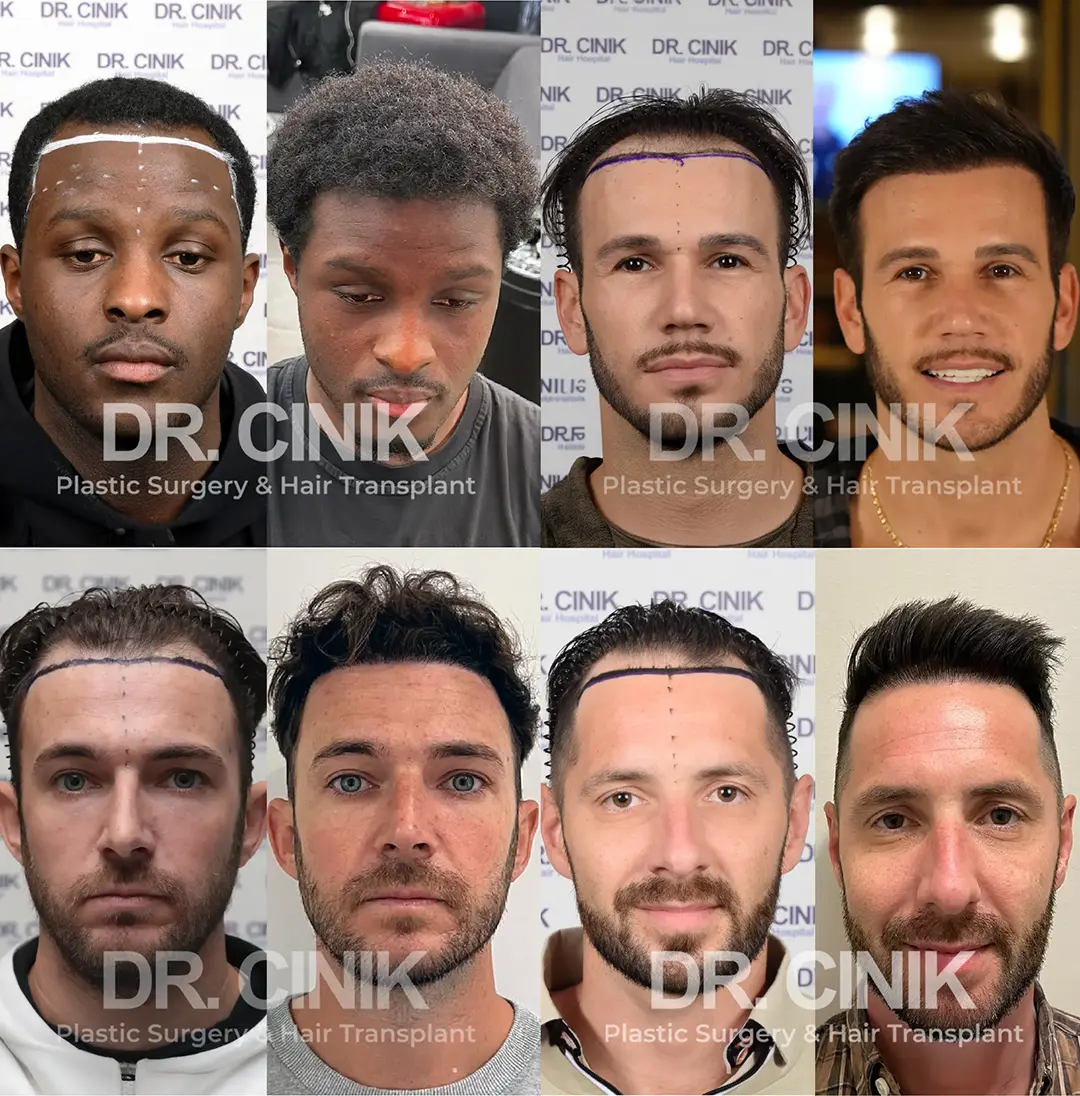A receding hairline is a common concern that affects many individuals, often leading to feelings of self-consciousness and a desire for effective solutions. Understanding the symptoms and causes of a receding hairline is the first step toward addressing this issue. For those seeking a more permanent remedy, hair transplant options, including techniques like Follicular Unit Extraction (FUE)[vc_row equal_height="yes" pix_particles_check=""][vc_column width="1/4" content_align="text-center"][pix_team_member_circle name_bold="font-weight-bold" name_color="heading-default" name_size="h5" bold="" title_color="secondary" outer_border="1" color="primary-light" items="%5B%7B%22icon%22%3A%22pixicon-facebook3%22%2C%22item_link%22%3A%22https%3A%2F%2Ffacebook.com%2Fdremrahcinik%22%2C%22target%22%3A%22true%22%2C%22has_color%22%3A%22true%22%2C%22item_color%22%3A%22secondary%22%2C%22item_custom_color%22%3A%22%23333333%22%7D%2C%7B%22icon%22%3A%22pixicon-instagram2%22%2C%22item_link%22%3A%22https%3A%2F%2Finstagram.com%2Fdr.emrahcinik%22%2C%22target%22%3A%22true%22%2C%22has_color%22%3A%22true%22%2C%22item_color%22%3A%22primary%22%2C%22item_custom_color%22%3A%22%23333333%22%7D%2C%7B%22icon%22%3A%22pixicon-youtube3%22%2C%22item_link%22%3A%22https%3A%2F%2Fyoutube.com%2FDrEmrahCinik%22%2C%22target%22%3A%22true%22%2C%22has_color%22%3A%22true%22%2C%22item_color%22%3A%22red%22%2C%22item_custom_color%22%3A%22%23333333%22%7D%5D" name="DR. Emrah CINIK" title="Medical Doctor" image="52"][alertblock secondary_font="secondary-font"..., offer promising results.
In this article, we will explore what a receding hairline is, its underlying causes, and the various factors to consider before undergoing a hair transplant. We will discuss the criteria of a suitable candidate for a hairline hair transplant, the types of hairlines that are easier to treat, and the potential benefits of a receding hairline hair transplant.
Besides, we will address specific considerations for receding hairline hair transplants for both men and women, as well as the risks and recovery process associated with these procedures. By the end, readers will have a comprehensive understanding of hairline hair transplants and how they can help restore confidence and appearance.
What Is a Receding Hairline?
Males experience receding hairlines more often than females, but it can happen to anyone. While there’s no cure for a receding hairline, medications can help slow down hair loss and stimulate new growth.
Pattern baldness, or androgenetic alopecia, is a natural part of aging that affects about 50% of both men and women. For men, receding hairlines usually begin just above the temples. In women, hair loss tends to show as diffuse thinning on the top of the head.
Though hair loss is often associated with aging, it can sometimes result from underlying conditions. In men, a receding hairline is often the first sign of pattern baldness, progressing through distinct stages.
It typically starts at the temples and may look a bit uneven at first. Eventually, it forms a shape that resembles an “M.” As time goes on, hair may thin out on the top or back of the head, leading to a bald spot.
These bald areas can grow larger and connect, often leaving a horseshoe-shaped pattern around the sides and back of the head.
What Are the Symptoms of a Receding Hairline?
You might wonder when exactly does a receding hairline start to develop? Well, the answer is that a receding hairline in males can start anytime after puberty, and by the late 30s, many men show signs of recession.
Typically, it begins above the temples and moves backward across the top of the head, often leaving a bare scalp surrounded by a ring of hair. Even as the hair thins, some still grows on top.
While the recession usually starts above the temples, hair in the middle may grow closer to the forehead, creating a “widow’s peak” with its distinctive V-shape.
Eventually, both sides and the back of the head can become bare, but many men retain some hair unless they decide to shave it off.
For females, hair loss often starts in the middle of the scalp, and over time, thinning can also appear at the temples.
What Causes Hairline to Recede?
Underneath your scalp, there are thousands of follicles that produce millions of hairs. These hairs fall out periodically and are replaced by new ones, with some people losing dozens every day.
However, if damage occurs to the hair follicles or a medical issue disrupts the growth cycle, a receding hairline may result.
Here are some potential reasons for hair loss:
- Family ancestry
Hair loss can be inherited from one generation to the next, often traced down from the mother’s side. Both males and females may experience a receding hairline due to this genetic factor. In this case, hair follicles shrink over time, leading to reduced hair growth.
- Hormonal changes
Hormones may also play a role in hair loss for women, though the relationship between hormones and female pattern hair loss is less understood than in men. For example, many women experience significant hair loss after menopause without major changes to their hairline.
- Old age
Ultimately, hair loss becomes inevitable for nearly everyone at some point in life. Hair growth may gradually slow, and eventually, the hair may begin to change color.
What Is a Receding Hairline Hair Transplant?

The gist of any hair transplant is that hair follicles are taken from a high-density area and implanted in a low-density area. The high-density area is referred to as a “donor area[vc_row equal_height="yes" pix_particles_check=""][vc_column width="1/4" content_align="text-center"][pix_team_member_circle name_bold="font-weight-bold" name_color="heading-default" name_size="h5" bold="" title_color="secondary" outer_border="1" color="primary-light" items="%5B%7B%22icon%22%3A%22pixicon-facebook3%22%2C%22item_link%22%3A%22https%3A%2F%2Ffacebook.com%2Fdremrahcinik%22%2C%22target%22%3A%22true%22%2C%22has_color%22%3A%22true%22%2C%22item_color%22%3A%22secondary%22%2C%22item_custom_color%22%3A%22%23333333%22%7D%2C%7B%22icon%22%3A%22pixicon-instagram2%22%2C%22item_link%22%3A%22https%3A%2F%2Finstagram.com%2Fdr.emrahcinik%22%2C%22target%22%3A%22true%22%2C%22has_color%22%3A%22true%22%2C%22item_color%22%3A%22primary%22%2C%22item_custom_color%22%3A%22%23333333%22%7D%2C%7B%22icon%22%3A%22pixicon-youtube3%22%2C%22item_link%22%3A%22https%3A%2F%2Fyoutube.com%2FDrEmrahCinik%22%2C%22target%22%3A%22true%22%2C%22has_color%22%3A%22true%22%2C%22item_color%22%3A%22red%22%2C%22item_custom_color%22%3A%22%23333333%22%7D%5D" name="DR. Emrah CINIK" title="Medical Doctor" image="52"][alertblock secondary_font="secondary-font"...,” which typically includes the sides and back of your head. The low-density area, usually the crown, mid-parting, or hairline, is referred to as the “recipient site.”
In a hairline hair transplant, your hairline is considered the “recipient site.” This means that hair grafts[vc_row equal_height="yes" pix_particles_check=""][vc_column width="1/4" content_align="text-center"][pix_team_member_circle name_bold="font-weight-bold" name_color="heading-default" name_size="h5" bold="" title_color="secondary" outer_border="1" color="primary-light" items="%5B%7B%22icon%22%3A%22pixicon-facebook3%22%2C%22item_link%22%3A%22https%3A%2F%2Ffacebook.com%2Fdremrahcinik%22%2C%22target%22%3A%22true%22%2C%22has_color%22%3A%22true%22%2C%22item_color%22%3A%22secondary%22%2C%22item_custom_color%22%3A%22%23333333%22%7D%2C%7B%22icon%22%3A%22pixicon-instagram2%22%2C%22item_link%22%3A%22https%3A%2F%2Finstagram.com%2Fdr.emrahcinik%22%2C%22target%22%3A%22true%22%2C%22has_color%22%3A%22true%22%2C%22item_color%22%3A%22primary%22%2C%22item_custom_color%22%3A%22%23333333%22%7D%2C%7B%22icon%22%3A%22pixicon-youtube3%22%2C%22item_link%22%3A%22https%3A%2F%2Fyoutube.com%2FDrEmrahCinik%22%2C%22target%22%3A%22true%22%2C%22has_color%22%3A%22true%22%2C%22item_color%22%3A%22red%22%2C%22item_custom_color%22%3A%22%23333333%22%7D%5D" name="DR. Emrah CINIK" title="Medical Doctor" image="52"][alertblock secondary_font="secondary-font"... taken from the donor area will be implanted into the temples (and sometimes the forehead) to level out the previously M-shaped hairline.
In this type of hair transplant surgery, patients will achieve a natural-looking flat hairline that does not show signs of recession. This, in turn, can make the patient appear years younger, enhancing their overall appearance and confidence.
Which Receding Hairline Type Is Easier to Transplant?
Your hair type does not significantly impact the process of hair transplantationHair transplantation is a surgical procedure that involves the extraction of hair follicles from a designated donor site, followed by... and the reconstruction of the hairline. However, certain characteristics can make the procedure simpler and shorten the operation time. These include:
- Low hairline
- Straight hairline
- Minimally receded temples
- Low forehead
Factors to Consider Before a Hairline Hair Transplant
It is inevitable to know that different variations of the hairline can affect how your procedure proceeds and whether you are a candidate for it. Some key variables in this decision include:
- Muscle borders: The limit below which hair cannot be implanted is defined by the facial muscles.
- Gender differences: For a masculine appearance, a straight front hairline is preferred, while a more inclined back hairline is typical for a feminine look.
- Type of hairline: Identifying an existing hairline is important for designing a new one.
- Donor hair quality and quantity: Adequate amounts of healthy donor hair are necessary for harvesting and transplanting onto your hairline.
- Scarring: DHI and FUE, the most popular techniques, cause minimal scarring post-operatively.
- Perfect age: The ideal age for a transplant occurs when an individual has completed their hair loss pattern, typically between 25 and 75.
- Medical evaluation: Skin diseases, conditions that may affect hair, and ongoing hair loss can impact the success of your results.
Who May Get a Hair Transplant for a Receding Hairline?
Seriously considering a hair transplant for your receding hairline? Here are some factors to consider:
- Sufficient age and stabilized hair loss: Candidates should ideally be over 27 and have stabilized hair loss, often supported by medications like Finasteride or Minoxidil, for long-lasting results.
- Long-term perspective: The hairline design should consider how it will look in 15-20 years to maintain a natural appearance.
- Professional evaluation: Consulting a hair transplant surgeon is essential for discussing options, setting realistic expectations, and creating a personalized hairline design.
Graft Requirements for a Hairline Only Transplant

When considering a hairline transplant, several factors influence the number of hair grafts needed. These are:
Extent of hair loss: The level of hair loss and baldness pattern determine graft requirements. Individuals with early thinning will need fewer grafts than those with more severe balding.
Donor hair availability: A larger, healthy donor area allows for more grafts to be harvested. Limited donor hair may restrict the number of grafts available for transfer.
Hair characteristics: Natural hair traits like texture, thickness, and color impact graft needs. Thicker or curlier hair often provides better coverage, requiring fewer grafts compared to fine, straight hair.
Desired hair density and coverage: The look you want influences graft count. A natural, thinner hairline requires fewer grafts, while a fuller appearance needs a higher graft count.
Calculating Hair Grafts for a Hairline Hair Transplant
Commenting on this point, Dr. Emrah Cinik, our hair transplant expert at Dr. Cinik, says, “To determine the number of hair grafts needed for a receding hairline hair transplant, the primary factor is the stage of hair loss. Classification according to Norwood categories provides an approximate estimation of the required grafts to achieve the desired outcome.”
The number of grafts can also vary based on the specific zones of the scalp being treated. Generally, fewer grafts are needed to restore a receding hairline or fill in the temples, but this requires precise technique.
For fairly recessed hairlines, a patient may need between 500 and 1,500 grafts. When addressing both the hairline and temples, the total may increase by an additional 200-300 grafts, depending on the severity of thinning.
How Does a Receding Hairline Hair Transplant Work?
The consultation is the first step in a hairline procedure, where you and your surgeon design the hairline, considering styles like a low straight line or corrections for irregularities.
Day of Surgery:
- Numbing: Both donor and recipient sites are numbed.
- Graft Extraction: Hair grafts are harvested from the donor site.
- Graft Placement: Follicles are placed into their designated areas.
The procedure is painless due to local anesthesia[vc_row equal_height="yes" pix_particles_check=""][vc_column width="1/4" content_align="text-center"][pix_team_member_circle name_bold="font-weight-bold" name_color="heading-default" name_size="h5" bold="" title_color="secondary" outer_border="1" color="primary-light" items="%5B%7B%22icon%22%3A%22pixicon-facebook3%22%2C%22item_link%22%3A%22https%3A%2F%2Ffacebook.com%2Fdremrahcinik%22%2C%22target%22%3A%22true%22%2C%22has_color%22%3A%22true%22%2C%22item_color%22%3A%22secondary%22%2C%22item_custom_color%22%3A%22%23333333%22%7D%2C%7B%22icon%22%3A%22pixicon-instagram2%22%2C%22item_link%22%3A%22https%3A%2F%2Finstagram.com%2Fdr.emrahcinik%22%2C%22target%22%3A%22true%22%2C%22has_color%22%3A%22true%22%2C%22item_color%22%3A%22primary%22%2C%22item_custom_color%22%3A%22%23333333%22%7D%2C%7B%22icon%22%3A%22pixicon-youtube3%22%2C%22item_link%22%3A%22https%3A%2F%2Fyoutube.com%2FDrEmrahCinik%22%2C%22target%22%3A%22true%22%2C%22has_color%22%3A%22true%22%2C%22item_color%22%3A%22red%22%2C%22item_custom_color%22%3A%22%23333333%22%7D%5D" name="DR. Emrah CINIK" title="Medical Doctor" image="52"][alertblock secondary_font="secondary-font"..., and there’s no need for an overnight stay. Advanced instruments are used to minimize scarring and recovery. Your surgeon grades and places each follicular unit according to a pre-agreed mapping plan, ensuring a natural blend with existing hair. The implanted follicles will heal and gradually start to grow.
Temple Vs Lowering: Hairline Hair Transplant Surgery
A hairline hair transplant can be of two major types: hairline lowering and temple restoration surgery. These are procedures that can be done using either follicular unit extraction (FUE) or follicular unit transplantation (FUT). To be specific, almost all hair transplants today use the FUE technique.
Temple Restoration Hair Transplant
Most commonly, hairline surgery is performed on younger patients aged 27-35 who are experiencing the first signs of male pattern baldness. In this procedure, the hair transplant surgeon focuses on the temple area where hair is absent.
Of the two surgeries done on the hairline, this one produces the most natural outcome, as no further modification is needed to lower the hairline.
Hairline Lowering Hair Transplant
Male pattern hair loss progresses with the backward recession of the hairline, often compressing it into the temporal regions. In these cases, more radical measures may be necessary to lower the patient’s hairline.
The second hairline treatment procedure is hairline-lowering surgery, which is more complex and usually costs more than the simpler temple restoration procedure.
During this procedure, donor hair is used to reduce the distance between the hairline and eyebrows, making the forehead appear smaller.
Which Hair Transplant Technique Is the Best for Receding Hairline?
One of the most popular hair transplantation methods is Follicular Unit Extraction (FUE). It creates a natural-looking hairline by completely individualizing the hairline for each patient and harvesting hair grafts without exception from individual follicles.
A commonly cited rival to FUE is Direct Hair Implantation (DHI), a more advanced method where hair follicles are extracted one by one using a specialized tool and immediately implanted into the balding area. This technique allows for greater precision and control during the implantation process.
What’s FUE, and How Does It Help to Treat Receding Hairlines?
One of the most important hair transplant methods is Follicular Unit Extraction, commonly referred to as FUE. But what is FUE, and how does it provide a natural hairline and an enduring remedy for hair loss?
Understanding the Process: Follicular Unit Extraction is said to be a minimally invasive hair transplant that does wonders in creating a natural look. Unlike other methods, it does not leave a scalper strip but uses the extraction of individual follicular units which then get transplanted to the affected area.
Natural Hairline Design: One FUE key benefit is its precision in natural hairline design. The hair surgeon, therefore, carefully transplants the follicular units at the specific angle and direction of existing hair growth, thus achieving an artistic touch that makes worked-in hairs truly indistinguishable from original ones.
Minimal Recovery Time: FUE has a shorter recovery time than any alternative hair transplantation technique. Patients can resume daily activities after FUE within several days, making this a feasible option for anyone with a busy lifestyle
Read more: The Top 5 Benefits of Choosing Turkey for an FUE Hair Transplant
Receding Hairline Transplant Without Shaving

A hair transplant for receding hairlines can be performed without shaving the head, utilizing techniques like Unshaven Follicular Unit Extraction (UFUE) and Unshaven Follicular Unit Transplantation (UFUT).
These methods allow patients to keep most or all of their hair intact, as only a small portion of the donor area at the back and sides needs to be shaved. This less-invasive approach facilitates discreet recovery while ensuring that the transplanted hair blends seamlessly with the existing hair, resulting in a natural-looking appearance.
Receding Hairline Transplant Risks
Success rates for hair transplants can reach as high as 98% for optimal results, but this is contingent on having a skilled surgeon and strictly following recovery instructions. An unsuccessful procedure may lead to:
- An uneven hairline
- A hairline that is too straight
- An artificial appearance
- A hairline that does not match feminine or masculine features
- A hairline that is inconsistent with ethnic characteristics
- A “doll-like” hair appearance
Read more: 5 Key Factors Shaping Hair Transplant Success in Istanbul
Receding Hairline Transplant Recovery
The success of a hairline transplant relies on following the doctor’s orders and ensuring a precise surgical procedure. Most patients can go home the same day, with rare overnight stays.
In the first week, you might experience some scratching, bleeding, and mild pain. Your doctor will prescribe medications and provide recovery instructions. Sleep may be uncomfortable, which is important for the transplant’s success.
Over the coming months, you may experience loss of the newly planted hairs, which is normal and not a sign of failure. Around three months post-surgery, some itching may occur due to new hair growth.
Final results are typically visible within a year, although some individuals may take up to 18 months to achieve the desired outcome.
Receding Hairline Transplant Aftercare Instructions
Avoid tight hairstyles, and ensure that clips, bands, or hair ties are always loose to prevent stress on your hair. For loose hairstyles, consider the following options:
- Low bun
- Low ponytail
- Top half-knot
- Bandanna
You may need to wait a few days to a week before wearing a bandana, and be sure to consult your doctor before wearing any type of hat.
How Long Does a Hairline Transplant Last?
Results will remain permanent. Follicles from the healthy donor area form the newly created hairline. So, like the hairs at the back of the head, they are not lost and remain permanent. The survival rates of transplanted hair follicles are between 90% and 100%.
What Are the Benefits of a Hair Transplant for a Receding Hairline?
Researching the efficacy of hair transplants for receding hairlines is important, as advancements in the field have yielded promising results.
Success Rates: Modern hairline surgeries have high success rates, with effective extraction and implantation techniques leading to strong graft retention.
- Natural Results: The aim is to achieve a natural appearance, as transplanted hair matches the texture and direction of the patient’s original hair, blending seamlessly.
- Longevity: Transplanted hair grafts are typically permanent, remaining intact unless affected by unforeseen circumstances or underlying medical conditions.
- International Approach: Techniques like follicular unit transplantation consider various factors, including hair density and distribution, ensuring even regrowth.
On the effectiveness of the hair transplant procedure for a receding hairline, Dr. Cinik says, “Individual outcomes may vary based on donor hair quality, surgeon skill, and post-operative care, making it essential to choose a reputable clinic and experienced surgeon for optimal results and confidence in your new hairline.”
Hair Transplant for Receding Hairline: Women vs. Men

Recession is the most common type of baldness in women, primarily affecting the hairline. Factors like androgenetic alopecia, stress, hormonal changes, and certain diseases contribute to hair loss. A hair transplant can effectively restore the hairline, often enhancing facial profiles with a rounded shape.
When donor hair is limited, the focus is on the frontal hairline and temples to create density. Women’s hairlines have unique growth patterns, making replication during surgery more complex. After the transplant, styling and treatments can improve the new hair’s appearance.
To minimize visible scarring, it’s advisable to avoid short haircuts. Some fallout may occur after the transplant, even in healthy follicles, so awareness of this is important.
Receding Hairline Hair Transplant Before and After
Conclusion
A receding hairline can significantly impact an individual’s self-esteem and overall appearance, but understanding the options available can empower those affected. Hair transplants, particularly techniques like Follicular Unit Extraction (FUE), have evolved to offer effective and natural-looking results. By considering factors such as the type of hairline, individual goals, and specific needs, patients can make informed decisions about their treatment.
Ultimately, whether you’re exploring a hair transplant for cosmetic reasons or to combat hereditary hair loss, it’s essential to consult with a qualified specialist. With the right guidance and care, a hair transplant can not only restore your hairline but also boost your confidence and enhance your quality of life. As advancements in the field continue, individuals facing hair loss can look forward to a range of options that cater to their unique situations.
Frequently Asked Questions:
Does a Hair Transplant Work on a Receding Hairline?
Yes, a hair transplant can effectively restore a receding hairline by transferring healthy hair follicles to the affected areas.
How Many Grafts Do You Need For a Hairline?
For hairlines that are somewhat recessed, a patient may require about 500 to 1,500 grafts. If both the hairline and the temples are addressed together, the total number of grafts needed may increase by an additional 200 to 300, depending on the severity of the thinning condition.
How High Should the Hairline Be for a Hair Transplant?
Hairlines should ideally rest at the transition from the forehead to the scalp and never be positioned lower than that. The slope of the hairline should taper upward from the lowest central point when viewed in profile.
If I want to get a hair transplant just for a specific part of my hairline, will I still need to shave my entire head for the procedure?
Shaving the entire head is typically not necessary for a hair transplant focused on a specific area of your hairline. Most clinics provide options that allow only the donor area to be shaved, enabling you to keep your existing hair in other regions while undergoing the procedure.
Are 1500 Grafts Enough for a Hairline?
1,500 hair grafts are considered a moderate range, generally sufficient to restore mild hair loss around the hairline, address initial balding or thinning spots, or provide a less extensive form of frontal hairline restoration.
How Do I Know If My Hairline Is Receding or Just Maturing?
While there are some similarities, a receding hairline usually presents a more pronounced look. A receding hairline may appear uneven and sharp, in contrast to a mature hairline, which typically has a softer ‘M’ or ‘V’ shape. In a mature hairline, the hair thinning or loss is generally more uniform on either side.
Can a Hair Transplant Fix a Mature Hairline?
Among all the treatments for receding hairlines, hair transplants are often considered the best option. They can effectively restore lost hair on both the front hairline and the crown, often resulting in permanent outcomes.


